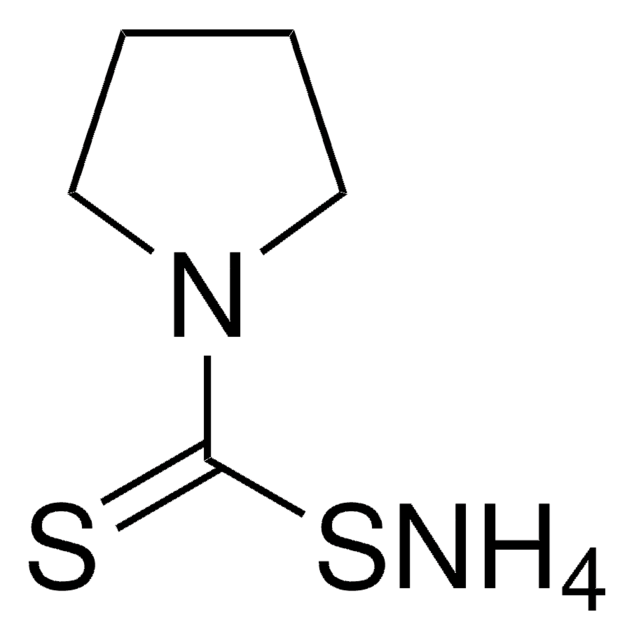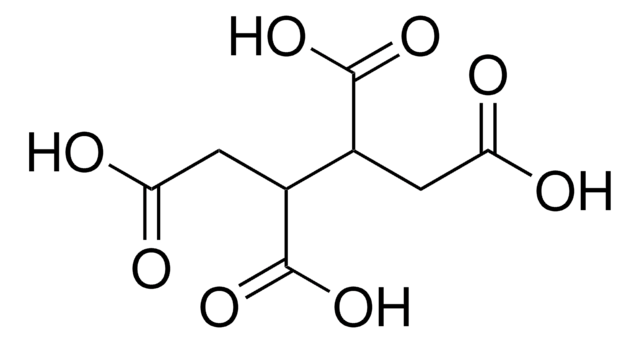04434
Sodium hypophosphite
puriss., meets analytical specification of BPC63, anhydrous, 98-101%
About This Item
Prodotti consigliati
Grado
puriss.
Saggio
98-101%
Forma fisica
powder or crystals
Qualità
meets analytical specification of BPC63
Impurezze
≤0.001% heavy metals (as Pb)
≤0.2% free alkali (as CaO)
Perdita
≤1% loss on drying, 105 °C, 2 h
Solubilità
water: soluble 909 g/L at 30 °C
Densità
1.77 g/cm3 at 20 °C
Anioni in tracce
chloride (Cl-): ≤200 mg/kg
sulfate (SO42-): ≤200 mg/kg
Cationi in tracce
As: ≤2 mg/kg
Fe: ≤10 mg/kg
Stringa SMILE
[Na+].[O-][PH2]=O
InChI
1S/Na.H3O2P/c;1-3-2/h;3H2,(H,1,2)/q+1;/p-1
SIGUVTURIMRFDD-UHFFFAOYSA-M
Cerchi prodotti simili? Visita Guida al confronto tra prodotti
Categorie correlate
Descrizione generale
Applicazioni
- Synthesis and characterization of chitosan-copper nanocomposites and their catalytic properties for 4-nitrophenol reduction.: This study explores the synthesis of chitosan-copper nanocomposites using sodium hypophosphite as a reducing agent. The resulting nanocomposites are characterized and their catalytic properties for the reduction of 4-nitrophenol are evaluated, demonstrating the utility of sodium hypophosphite in catalytic applications (Pang et al., 2024).
- The Durable Chitosan Functionalization of Cellulosic Fabrics.: This research focuses on the durable functionalization of cellulosic fabrics with chitosan using sodium hypophosphite as a cross-linking agent. The study highlights the improved properties of the fabrics, showcasing sodium hypophosphite′s role in textile enhancement (Flinčec Grgac et al., 2023).
- Hypophosphite cross-linked starch succinate/chitosan membranes as alternative for packaging and pharmaceutical application.: The study investigates the development of starch succinate/chitosan membranes cross-linked with sodium hypophosphite, proposing these materials as potential alternatives for packaging and pharmaceutical applications (Bajer, 2023).
- Tensile Strength Improvements of Ramie Fiber Threads through Combination of Citric Acid and Sodium Hypophosphite Cross-Linking.: This research improves the tensile strength of ramie fiber threads by combining citric acid and sodium hypophosphite for cross-linking, demonstrating significant enhancements in fiber properties for industrial applications (Wulandari et al., 2023).
- Nickel-Catalyzed Sodium Hypophosphite-Participated Direct Hydrophosphonylation of Alkyne toward H-Phosphinates.: This study demonstrates a novel nickel-catalyzed hydrophosphonylation of alkynes using sodium hypophosphite. The research showcases the efficiency of sodium hypophosphite in producing H-phosphinates, highlighting its significance in chemical synthesis (Qian et al., 2023).
Codice della classe di stoccaggio
13 - Non Combustible Solids
Classe di pericolosità dell'acqua (WGK)
WGK 2
Punto d’infiammabilità (°F)
Not applicable
Punto d’infiammabilità (°C)
Not applicable
Certificati d'analisi (COA)
Cerca il Certificati d'analisi (COA) digitando il numero di lotto/batch corrispondente. I numeri di lotto o di batch sono stampati sull'etichetta dei prodotti dopo la parola ‘Lotto’ o ‘Batch’.
Possiedi già questo prodotto?
I documenti relativi ai prodotti acquistati recentemente sono disponibili nell’Archivio dei documenti.
I clienti hanno visto anche
Il team dei nostri ricercatori vanta grande esperienza in tutte le aree della ricerca quali Life Science, scienza dei materiali, sintesi chimica, cromatografia, discipline analitiche, ecc..
Contatta l'Assistenza Tecnica.










